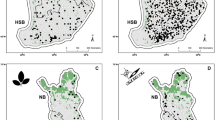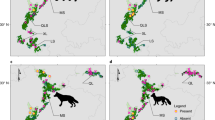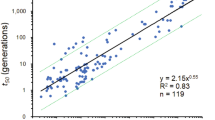Abstract
In recent years, a number of authors1–3 have suggested several geometric principles for the design of nature reserves based upon the hypothesis that nature reserves are analogous to land-bridge islands. Land-bridge islands are islands that were formerly connected to the mainland and were created by a rise in the level of the ocean. Land-bridge islands are considered supersaturated with species in that the ratio of island to mainland species numbers is higher than expected from the area of the island. As a result, the rate of extinction should exceed the rate of colonization on a land-bridge island, resulting in a loss of species that is suggested to be related to the size and degree of isolation of the island4If nature reserves are considered to be similar to land-bridge islands, because most are slowly becoming isolated from their surroundings by habitat disturbance outside the reserves4–8, several predictions follow. First, the total number of extinctions should exceed the total number of colonizations within a reserve; second, the number of extinctions should be inversely related to reserve size; and third, the number of extinctions should be directly related to reserve age. I report here that the natural post-establishment loss of mammalian species in 14 western North American national parks is consistent with these predictions of the land-bridge island hypothesis and that all but the largest western North American national parks are too small to retain an intact mammalian fauna.
This is a preview of subscription content, access via your institution
Access options
Subscribe to this journal
Receive 51 print issues and online access
$199.00 per year
only $3.90 per issue
Buy this article
- Purchase on Springer Link
- Instant access to full article PDF
Prices may be subject to local taxes which are calculated during checkout
Similar content being viewed by others
References
Diamond, J. M. Biol. Conserv. 7, 129–146 (1975).
Terborgh, J. in Tropical Ecological Systems: Trends in Terrestrial and Aquatic Research (eds Golley, F. B. & Medina, E.) 369–380 (Springer, New York, 1975).
Wilson, E. O. & Willis, E. O. in Ecology and Evolution of Communities (eds Cody, M. L. & Diamond, J. M.) 522–534 (Harvard University Press, Cambridge, 1975).
Diamond, J. M. Proc natn. Acad. Sci. U.S.A. 69, 3199–3203 (1972).
Wright, G. M., Dixon, J. S. & Thompson, B. H. Fauna Series No. 1, Vol. 1 (US Govt Printing Office, Washington DC, 1932).
Soulé, M. E., Wilcox, B. A. & Holtby, C. Biol. Conserv. 15, 259–272 (1979).
National Park Service, State of the Parks - 1980; A Report to the Congress (US Dept of the Interior, Washington DC, 1980).
Newmark, W. D. Biol. Conserv. 33, 197–208 (1985).
Runte, A. National Parks: The American Experience (University of Nebraska, Lincoln, 1979).
Wilcox, B. A. in Conservation Biology: An Evolutionary-Ecological Perspective (eds Soulé, M. E. & Wilcox, B. A.) 95–117 (Sinauer, Sunderland, 1980).
Terborgh, J. & Winter, B. in Conservation Biology: An Evolutionary-Ecological Perspective (eds Soulé, M. E. & Wilcox, B. A.) 119–133 (Sinauer, Sunderland, 1980).
Diamond, J. M. in Extinctions (ed. Nitecki, M. H.) 191–246 (University of Chicago Press, Chicago, 1984).
Newmark, W. D. Ph.D., thesis, Univ. Michigan (1986).
Mader, H. J. Biol. Conserv. 29, 81–96 (1984).
Oxley, D. J., Fenton, M. D. & Carmondy, G. R. J. appl. Ecol. 11, 51–59 (1974).
Pedersen, R. J. in Conf. Proc. Recreational Impact of Wildlands (eds Ittner, R., Potter, D. R., Agee, J. K. & Anshell, S.) 169–173 (US Forest Service, 1979).
Wegner, J. F. & Merriam, G. J. appl. Ecol. 16, 349–357 (1979).
Brown, J. H. & Kodrick-Brown, A. Ecology 58, 445–449 (1977).
Kilgore, B. M. & Taylor, D. Ecology 60, 129–142 (1979).
Loope, L. L. & Gruell, G. E. Quat. Res. 3, 425–443 (1973).
McNeil, R. C. & Zobel, D. B. NW Sci. 54, 30–46 (1980).
Vankat, J. L. & Major, J. J. Biogeogr. 5, 377–402 (1978).
Author information
Authors and Affiliations
Rights and permissions
About this article
Cite this article
Newmark, W. A land-bridge island perspective on mammalian extinctions in western North American parks. Nature 325, 430–432 (1987). https://doi.org/10.1038/325430a0
Received:
Accepted:
Issue Date:
DOI: https://doi.org/10.1038/325430a0
This article is cited by
-
Enhanced regional connectivity between western North American national parks will increase persistence of mammal species diversity
Scientific Reports (2023)
-
Likelihood of elephant death risk applying kernel density estimation model along the railway track within biodiversity hotspot of Bhutan–Bengal Himalayan Foothill
Modeling Earth Systems and Environment (2020)
-
Do forest plants conform to the theory of island biogeography: the case study of bog islands
Biodiversity and Conservation (2014)
-
Protected species use of a coastal marine migratory corridor connecting marine protected areas
Marine Biology (2014)
-
Chronology of Awareness About US National Park External Threats
Environmental Management (2012)
Comments
By submitting a comment you agree to abide by our Terms and Community Guidelines. If you find something abusive or that does not comply with our terms or guidelines please flag it as inappropriate.



